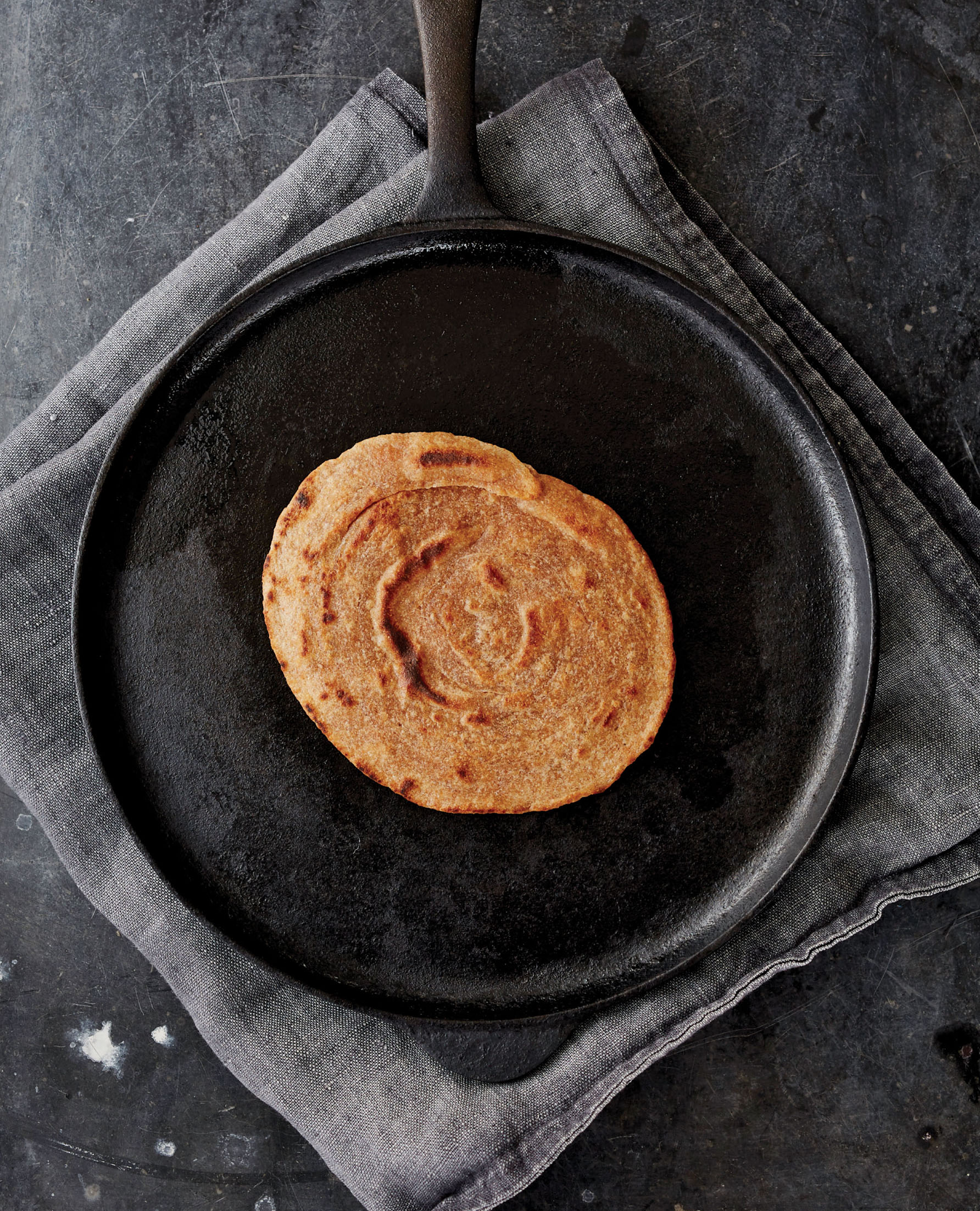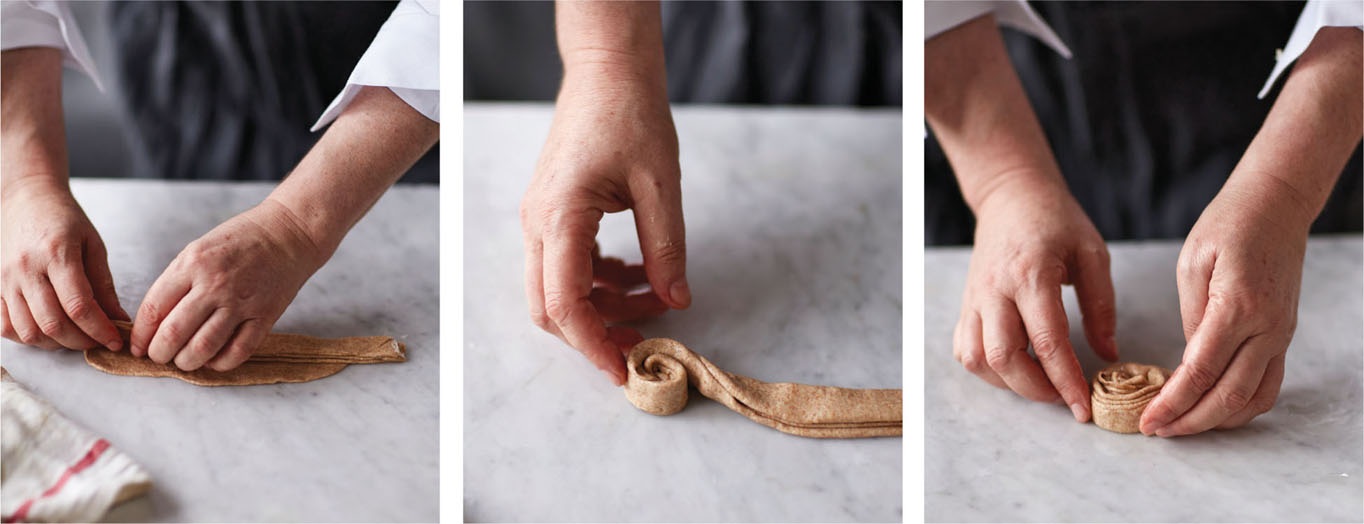INDIA | PAKISTAN

The classic technique for forming paratha (see “Multilayered Breads”) results in the most layers, but it is not so easy to master, so I use a much simpler method of folding the dough into squares, although it produces fewer layers. If you’d prefer to make your parathas round (see photographs below), flatten the dough the same way as directed in the recipe, but roll the round a little thinner. Fold the round into thin strips or roll it into a thin cylinder, taking care to brush the dough with the fat of your choice in between each step. (If you use tahini as the fat of choice, you will be making the Turkish tahinli katmer but with whole wheat flour.) Coil the folded strip into a small disk. Let it rest for 10 minutes, then flatten it out and cook the same way as for the square paratha.
Paratha are either baked in a tannur oven or cooked on a large hot plate or in a tawa, a very shallow skillet used in India and Pakistan. If you don’t have a tawa, just use a regular skillet. I use a nonstick one. Serve the parathas hot with curry or cheese or instead of bread with your meal.
MAKES 8 INDIVIDUAL PARATHAS
2 cups (225 g) whole wheat flour, plus all-purpose flour for kneading and shaping
¼ teaspoon fine sea salt
2 teaspoons vegetable oil
FAT (CHOOSE ONE)
Unsalted butter, melted
Vegetable oil
Ghee
1. Mix the flour and salt in a bowl and make a well in the center. Add the oil and ¾ cup (180 ml) water to the well and gradually bring in the flour until you have a rough dough.
2. Transfer the dough to a lightly floured work surface and knead for 3 minutes. Shape into a ball, invert the bowl over the dough, and let rest for 15 minutes. Knead for 3 more minutes, or until the dough is smooth and elastic. Shape into a ball. Cover with a damp kitchen towel and let rest for 30 minutes.

3. Divide the dough into 8 equal portions. Roll each portion into a ball and set the balls of dough to the side on a floured surface, covered with a damp towel. Place one ball on a lightly floured work surface and roll out to a round about ⅛ inch (3 mm) thick. Brush the round with the fat of your choice—the last ones I had in Pakistan were brushed with buffalo ghee and they were amazing—then fold one-third of the round over, then the other third over the folded side. Brush again with fat and fold one-third of the rectangle over, then fold in the other third to make a square. Flatten the dough to make a 6-inch (15 cm) square. Continue to make 3 more parathas.
4. Place a tawa or large skillet over medium heat and when the pan is hot, slip a paratha into the pan. Slip a little fat of choice under the paratha and cook until the dough starts bubbling, about 3 minutes. Flip the paratha over and cook until golden all over, another 3 minutes, slipping a little more of the fat of choice underneath it. Remove to a plate. Repeat with the remaining 3 parathas. Keep this first batch warm while you layer and cook the remaining 4 parathas.
SHEERMAL: Turn your paratha into sheermal, a northern Indian bread colored red with saffron water (although nowadays most bakers use turmeric water or, worse, colored water). Sheermal is usually round and I first had it at a nihari place in Hyderabad where, like most street-food stalls in India and Pakistan, they had a baker making breads to order. I got started talking with my neighbor and ordered sheermal so that I could try it. It was amazing, mainly because the bright-red color of the crust made a stunning contrast with the white insides. To turn paratha into sheermal, soak a couple of good pinches of saffron in ½ cup (125 ml) water for about 30 minutes. Shape the dough as directed and once it’s in the pan, brush the top with the saffron water to color it a reddish yellow.
MULTILAYERED BREADS
The specific technique used to produce a multilayered bread varies according to the type of bread and the country in which it’s made, but the principle is the same for all: You first have to flatten the dough, grease and/or flour it, and use one of several rolling or folding methods to create layers. In one method, the dough is rolled into a cylinder and then the cylinder is twisted as you flatten the dough again to create the layers. In another method, after flattening the dough you fold it into a rectangle and then into a square, or sometimes into a square or a triangle. There are also variations on the cylinder method, but the one I find most fascinating is that used in India to make paratha: The dough is rolled into a round, folded in half, and then rolled into a cone shape with the tip end folded inside the cone. The cone is then stood up on its fat end and twisted down before being flattened to produce the multilayered paratha, and all the time it is greased so that the layers separate as the paratha bakes.